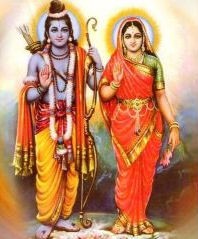A Simple Guide to Help Understand Hindu Gods
Sati
Sati - Shiva's First Wife
Lord Shiva's consort is Devi, the Mother-goddess and Divine Mother Energy. She appears in many different forms which including, Sati, the goddess of marital fidelity, the more peaceful Parvati (Uma in Thailand), and Kali, the goddess of death. Sati is a Hindu goddess of marital felicity and longevity; she is worshipped particularly by Hindu women who seek a long life for their husbands. She was the first consort of Shiva. In Hindu Mythology, Sati plays the role of luring Shiva from ascetic isolation into creative participation in the world.
The Goddess Sati took human birth at the bidding of Brahma, her grandfather. In bidding the Goddess Sati to take human birth, Brahma's design was that she should please Shiva with humble devotions and wed him. It was natural that Sati, as a child, adored the tales and legends associated with Shiva and grew up an ardent devotee.
| As Sati grew to womanhood, the idea of marrying anyone else, as proposed by her father Daksha (Brahma's son) became anathema to her. To win the respect of
the reclusive Shiva, she forsook the luxuries of her father's palace and retired to a
forest to devote herself to austerities and the worship of
Shiva. She
gradually renounced food itself, at one stage subsisting on one bilva leaf a day, and then giving up even that nourishment. Her prayers finally bore fruit
when, after testing her resolve,
Shiva finally acceded to her wishes and consented to make her his bride. Sati returned to her father's home to await her bridegroom, but found her father less than elated by the turn of events. The wedding was however held in due course, and Sati made her home with Shiva. Her father is depicted as an arrogant king who did not get on with his renunciate son-in-law and basically cut his daughter away from her family.
|
 |
Calling up a prayer that she may, in some future birth, be born the daughter of a father whom she could respect, Sati invoked her powers and immolated herself in the sacrificial fire.
Shiva sensed this catastrophe, and his rage was awesome. He created two ferocious creatures who wreaked havoc and mayhem on the scene of the horrific incident. Nearly all those present were indiscriminately felled overnight. Daksha himself was decapitated.
According to some traditions, it is believed that an angry Shiva performed the fearsome and awe-inspiring Tandava (Dance of Death) with Sati's charred body on his shoulders. According to one another version, Shiva placed Sati's body on his shoulder and ran about the world, crazed with grief. The Gods called upon Lord Vishnu to return Shiva to sanity. Vishnu used his powers to dismember Sati's lifeless body, following which Shiva regained his equanimity.
After the night of horror, Shiva, the all-forgiving, restored all those slain to life and granted them his blessings. Even the abusive and culpable Daksha was restored both his life and his kingship. His decapitated head was substituted for that of a goat Having learned his lesson, Daksha spent his remaining years as a devotee of Shiva. (This sounds like a forerunner of Shiva restoring Ganesha's life by installing the head of an elephant - anyway, if you ever see a painting of a person with the head of a goat you will know that is Sati's father Daksha)
Sati was then reborn as Parvati, daughter of Himavan, king of the mountains, and his wife, Mena. This time, she was born the daughter of a father whom she could respect and who appreciated Shiva ardently. Naturally, Parvati sought Shiva as her husband.
(Postscript: There used to be a Hindu ritual in India that when a Husband died his wife sacrificed herself on his funeral pyre just as Sati sacrificed herself for her husband Shiva. The practice was outlawed by the British but there is some speculation that it is still practiced today.)
Sati - Wikipedia
![]()
(Editor's note, March 19, 2010: This page is now being construction so come back again.)
![]()
![]()
For more information about our travels write to![]() Belli.
Belli.